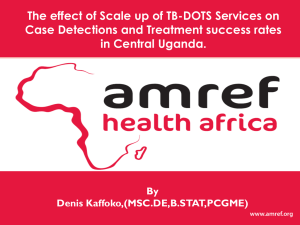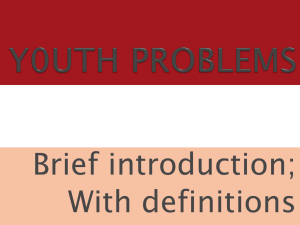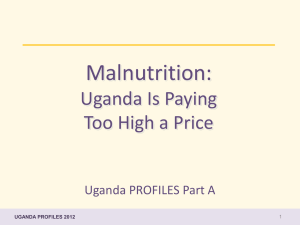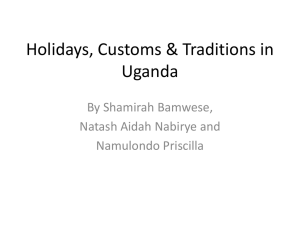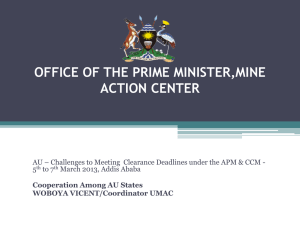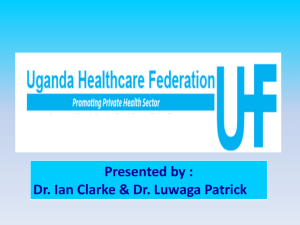Makerere-Sida-ARM-Science-Day-CoVAB
advertisement
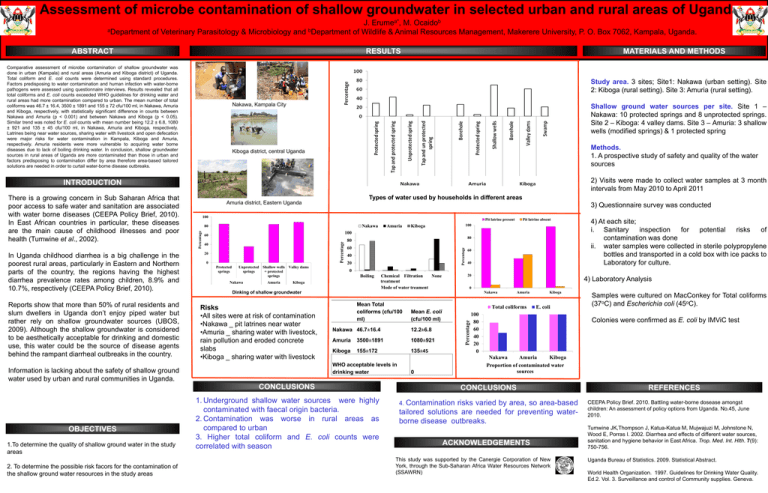
Assessment of microbe contamination of shallow groundwater in selected urban and rural areas of Ugandas J. Erumea*, M. Ocaidob aDepartment of Veterinary Parasitology & Microbiology and bDepartment of Wildlife & Animal Resources Management, Makerere University, P. O. Box 7062, Kampala, Uganda. ABSTRACT RESULTS Comparative assessment of microbe contamination of shallow groundwater was done in urban (Kampala) and rural areas (Amuria and Kiboga district) of Uganda. Total coliform and E. coli counts were determined using standard procedures. Factors predisposing to water contamination and human infection with water-borne pathogens were assessed using questionnaire interviews. Results revealed that all total coliforms and E. coli counts exceeded WHO guidelines for drinking water and rural areas had more contamination compared to urban. The mean number of total coliforms was 46.7 ± 16.4, 3500 ± 1891 and 155 ± 72 cfu/100 ml, in Nakawa, Amuria and Kiboga, respectively, with statistically significant difference in counts between Nakawa and Amuria (p < 0.001) and between Nakawa and Kiboga (p < 0.05). Similar trend was noted for E. coli counts with mean number being 12.2 ± 6.8, 1080 ± 921 and 135 ± 45 cfu/100 ml, in Nakawa, Amuria and Kiboga, respectively. Latrines being near water sources, sharing water with livestock and open defecation were major risks for water contamination in Kampala, Kiboga and Amuria, respectively. Amuria residents were more vulnerable to acquiring water borne diseases due to lack of boiling drinking water. In conclusion, shallow groundwater sources in rural areas of Uganda are more contaminated than those in urban and factors predisposing to contamination differ by area therefore area-based tailored solutions are needed in order to curtail water-borne disease outbreaks. MATERIALS AND METHODS Study area. 3 sites; Site1: Nakawa (urban setting). Site 2: Kiboga (rural setting). Site 3: Amuria (rural setting). Nakawa, Kampala City Shallow ground water sources per site. Site 1 – Nakawa: 10 protected springs and 8 unprotected springs. Site 2 – Kiboga: 4 valley dams. Site 3 – Amuria: 3 shallow wells (modified springs) & 1 protected spring Methods. 1. A prospective study of safety and quality of the water sources Kiboga district, central Uganda 2) Visits were made to collect water samples at 3 month intervals from May 2010 to April 2011 INTRODUCTION 100 Pit latrine present Nakawa 80 Amuria Kiboga 100 40 20 0 Protected springs Unprotected Shallow wells springs + protected springs Nakawa Amuria Valley dams 80 80 60 Percentage 60 40 20 2. To determine the possible risk facors for the contamination of the shallow ground water resources in the study areas 40 Kiboga 20 Chemical Filtration None treatment Mode of water treament Dinking of shallow groundwater Risks •All sites were at risk of contamination •Nakawa _ pit latrines near water •Amuria _ sharing water with livestock, rain pollution and eroded concrete slabs •Kiboga _ sharing water with livestock 4) Laboratory Analysis 0 Nakawa Mean Total coliforms (cfu/100 ml) Mean E. coli (cfu/100 ml) Nakawa 46.7±16.4 12.2±6.8 Amuria 3500±1891 1080±921 Kiboga 155±172 135±45 WHO acceptable levels in drinking water 1. Underground shallow water sources were highly contaminated with faecal origin bacteria. 2. Contamination was worse in rural areas as compared to urban 3. Higher total coliform and E. coli counts were correlated with season Amuria Total coliforms Kiboga E. coli 100 80 60 40 20 0 Samples were cultured on MacConkey for Total coliforms (37oC) and Escherichia coli (45oC). Colonies were confirmed as E. coli by IMViC test Nakawa Amuria Kiboga Proportion of contaminated water sources 0 CONCLUSIONS 1.To determine the quality of shallow ground water in the study areas 60 4) At each site; i. Sanitary inspection for potential risks of contamination was done ii. water samples were collected in sterile polypropylene bottles and transported in a cold box with ice packs to Laboratory for culture. 0 Boiling Information is lacking about the safety of shallow ground water used by urban and rural communities in Uganda. OBJECTIVES Pit latrine absent 100 Percentage Reports show that more than 50% of rural residents and slum dwellers in Uganda don’t enjoy piped water but rather rely on shallow groundwater sources (UBOS, 2009). Although the shallow groundwater is considered to be aesthetically acceptable for drinking and domestic use, this water could be the source of disease agents behind the rampant diarrheal outbreaks in the country. 3) Questionnaire survey was conducted Percentage In Uganda childhood diarrhea is a big challenge in the poorest rural areas, particularly in Eastern and Northern parts of the country, the regions having the highest diarrhea prevalence rates among children, 8.9% and 10.7%, respectively (CEEPA Policy Brief, 2010). Types of water used by households in different areas Amuria district, Eastern Uganda Percentage There is a growing concern in Sub Saharan Africa that poor access to safe water and sanitation are associated with water borne diseases (CEEPA Policy Brief, 2010). In East African countries in particular, these diseases are the main cause of childhood illnesses and poor health (Tumwine et al., 2002). CONCLUSIONS 4. Contamination risks varied by area, so area-based tailored solutions are needed for preventing waterborne disease outbreaks. ACKNOWLEDGEMENTS This study was supported by the Canergie Corporation of New York, through the Sub-Saharan Africa Water Resources Network (SSAWRN) REFERENCES CEEPA Policy Brief. 2010. Battling water-borne dosease amongst children: An assessment of policy options from Uganda. No.45, June 2010. Tumwine JK,Thompson J, Katua-Katua M, Mujwajuzi M, Johnstone N, Wood E, Porras I. 2002. Diarrhea and effects of different water sources, sanitation and hygiene behavior in East Africa. Trop. Med. Int. Hlth. 7(9): 750-756. Uganda Bureau of Statistics. 2009. Statistical Abstract. World Health Organization. 1997. Guidelines for Drinking Water Quality. Ed.2. Vol. 3. Surveillance and control of Community supplies. Geneva.
